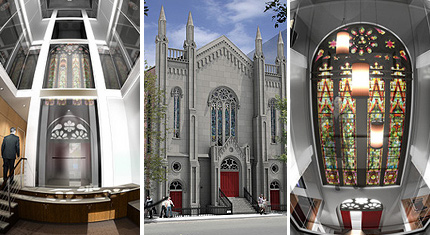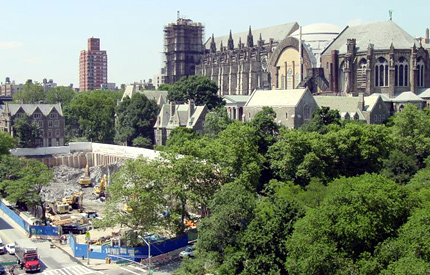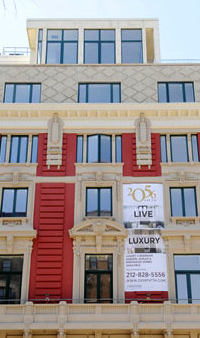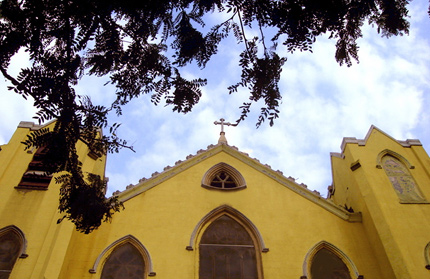
In the very different Greenwich Village of the 1960s, Washington Square Methodist Church was so active in the anti-Vietnam War movement that it earned the moniker the "peace church." Forty years later the building remains, providing a place for New Yorkers to "come to be reborn."
Not in a religious sense, however. Now it serves as a "private refuge" offering original stained glass, Italian white marble countertops and quartz and slate floors for those who can afford to pay upward of $3 million for one of its eight apartments.
If the church's role in the 1960s was emblematic of the times, so, some might say, is its function today. Many city churches, particularly in Manhattan, no longer offer sermons, choirs or Sunday schools. Instead, they serve as places of profit, enjoyment and in some cases even sin, a shift that can have major effect on their communities.
The High Cost of Worship
The conversion of many houses of worship springs from two trends: a decline in religious membership in parts of the city and the value of property here.
Recent figures indicate that over 80 percent of New Yorkers consider themselves as affiliated with a faith. That does not mean, though, that they attended services.
Over the past century, attendance at religious services in the city has dropped, especially in Manhattan. Demographic shifts from neighborhood to neighborhood have affected attendance at churches, synagogues, mosques and temples. In response, Cardinal Edward Egan of the New York Archdiocese announced a "realignment" plan that has shut down or "merged" some of the city's Catholic parishes. The Catholic Church has some particular problems -- for one, its funds have been depleted to settle lawsuits brought by victims of sex abuse. But the Catholic Church is not alone in its downsizing.
Many church and synagogue goers have left Manhattan to move to the outer boroughs and the suburbs. The Catholic Churches plan, for example, sees a need for more churches and people far beyond the city limits in Orange, Rockland and Putnam counties, as well as northern Westchester and Duchess counties.
Meanwhile Manhattan has become home to young single professionals who have a tendency to drop out of their congregations over time, said one Upper East Side pastor, the Rev. Kazimierz A. Kowalski of the Church of our Lady of Good Counsel. "Often times when people get wealthy, people get lazy. In biblical history, when people get fat, they forget where they got the fat from," Kowalski said.
Religious properties in New York, like everything here, tend to be expensive to maintain, a particular burden for churches that may be seeing their membership -- and financial support -- decline. At the same time, the real estate boom has made the churches and their land increasingly valuable -- if the property can be used for something other than prayer.
From Peace to Posh
Vacant churches, along with seemingly every other available space in Manhattan, frequently often become luxury apartments. For landmarked churches, the outer structure is maintained and the inside is gutted then polished to perfection. (Some churches have been turned into low-income housing, but this occurs more often in the outer boroughs.)
This is the case with Washington Square Methodist. In its space, FLAnk Architecture created Novare, featuring eight spacious, luxuriously appointed $3 million to $6 million apartments, six of them with original stained glass.
"All different kinds of buyers have looked at it. The stained glass in this church was not iconographic in any way. But it is for a particular type of buyer who is comfortable being a trailblazer," said the vice president of the Corcoran Group, Brian Babst, who is in charge of sales for the building.
The real estate developers of Horsford Poteat are formulating plans to convert several Harlem churches into apartments, maintaining worship space on the ground floors and building condos above it. A project manager from the company who requested anonymity since the deals have not been finalized said, "The church leaders approached us about trying to bring some revenue back." She said that in Harlem, where some blocks have several churches, many no longer have enough members to survive.
AFC Realty has already converted the former Harlem Gospel Temple Church at 2056 Fifth Avenue into 22 condos priced at from $645,000 to $1.575 million. About half have been claimed so far.
Dancing in the Aisles
Many churches use music in their services-- but not the kind heard in some of these buildings today. In perhaps the most dramatic shift in purpose, a handful of one-time churches have been converted into places to dance, drink and hookup.
The most notorious church-turned-nightclub was Chelsea's Limelight, which was owned by Peter Gatien, the "Club King" of the 1980s and '90s. The Limelight building was constructed in 1846 as the Episcopal Church of the Holy Communion. After 130 years, it was closed in an Episcopalian church merger. But because it was a landmark the building survived -- though its mission certainly shifted.
Gatien's club opened inside the Gothic stone walls in 1983. Several years later, though, Limelight (as well as Gatien's other clubs, including The Palladium and Tunnel) was targeted with drug dealing lawsuits as part of Mayor Rudolph Giuliani's "quality of life" improvement campaign. The club was repeatedly raided and shut down by the New York Police Department from 1995 through 1997.
Gatien was convicted of tax evasion in 1999 but acquitted of the charges that he had been involved in selling the drugs taken in his clubs in 1998. When reporters asked how would celebrate his vindication, he responded, apparently without irony, "Right now I'm just grateful to God. I want to go to church."
A few years later, new owners opened another club -- Avalon -- in the church. Hunk-O-Mania, the male strip revue, hosted weekly parties where people once took communion. Avalon closed in 2007 and the space is now vacant, although there have been rumors that it will soon be turned into a mini-mall.
Eating in the Pews
There are also church restaurants. At Providence on West 57th Street, few traces of the Manhattan Baptist Church remain. A sound system has been implanted in the organ, and chandeliers now cover the arched wood ceiling. Neon light blinks from a dance floor in one part of the building, and a bar fills the altar space.
Manhattan Baptist Church was shut down for budgetary reasons in the 1960s. Throughout the 1970s and '80s, the building was used by Media Sound Studios and musicians like Jimi Hendrix, John Lennon, Aerosmith, Billy Joel and The Rolling Stones recorded albums there. The building then housed Le Bar Bat, a popular nightspot, before Providence took over.
Battles for Survival
Many New Yorkers would see the changes at these churches as virtually inevitable. As manufacturing has declined, developers have converted old factories to museums, high tech offices and the Chelsea Market. Similarly, as church attendance has dropped, new uses must be found for houses of worship.
Given the role of churches in the lives of their members and their communities, though, some New Yorkers want to preserve them. The conflict has pitted houses of worship against preservationists in neighborhoods across the city. The preservationists argue that many churches, synagogues and mosques are historic and cultural treasures that must be kept for future generations. On the other side, religious leaders and congregations contend that historic preservation can pose significant hardships, costing money that should go toward advancing a religious mission and for charity.
One such dispute concerned St. Brigid's on the east end of Tompkins Square Park in the East Village. In the late 1990s, St. Brigid's staff discovered that the east wall of the aging building was moving in the eastern direction about a quarter of an inch each year. Egan deemed the structure unsafe for parishioners, and the church was closed in 2001. The archdiocese was originally going to repair it, then later it decided to demolish the building and lease the land.
The church remained, though, partially through the effort of the "Save St. Brigid" campaign. Its supporters noted the rich history of an institution created in the 1840s to serve New York's growing Irish Catholic community. The church's architecture reflects its origins. The arched ceiled, for example, is fashioned as an upside-down boat and was built by Irish people who immigrated here to escape the potato famine in the 1840s and then found work in East
The campaign sufferd a number of setbakcs in courts and at the Landmark Preservation Commission. Then on May 21, the archdiocese announced that St. Brigid's would not be razed after all. An anonymous contributor had donated $20 million. Half of that will go to restore the church, $8 million will aid St. Brigid's school and $2 million will, according to a statement from the archdiocese, provide an endowment for the parish "so that it might best meet the religious and spiritual needs of the people."
"This incredible gift not only enables us to preserve the traditions and spirit of St. Brigid’s founders, it also allows us to protect the traditions of religious freedom, family and community that are the very fabric of this neighborhood and others throughout the city," said Edwin Torres, a former St. Brigid's parishioner and the current chairman of Save St. Brigid.
While St. Brigid's has apparently been saved, the issues presented by the dispute remain. "It's a problem of the cost of maintaining the church versus the profitability of the land," said Torres, earlier this month.
The Catholic Church rarely sells off a building or a plot of land. Egan generally prefers to hold on to the property to use it for parochial schools or charity offices, according to the spokesman for the archdiocese, Joseph Zwilling. However, exceptions do exist.
One is St. Ann's Church, several blocks away from St. Brigid's on East 12th Street. It had not been an active Catholic church for 30 years when the archdiocese put it on the market and sold it to the Hudson Companies developers who designed a dormitory for New York University. The builder knocked down all the church except for the facade (an effort to appease its neighbors), which stands in front of the 26-story brick building. This new structure is now the highest building in the East Village and has met with persistent protests in the community.
Divide and Save?
In their efforts to survive, many churches have made compromises, selling pieces of property to make money to fund other operations. The Cathedral Church of St. John the Divine in Morningside Heights is a prime example. The Episcopal cathedral had been in a financial crisis for most of its life, ever since its planning began in 1873. In the past few years, the cathedral has announced several "real estate initiatives," parceling off pieces of the 11.3 acres surrounding the church- to developers.

After working with the city Landmarks Preservation Commission, the cathedral signed an deal with Columbia University that would enable Columbia to build an academic facility on the north side of the cathedral close. So far, no precise plans have been announced.
On the southeast side, the cathedral granted a 99-year lease to AvalonBay developers to build a modern, glassy 20-story apartment building. One fifth of the apartments will affordable housing that the cathedral will help fund.
"The real estate initiatives were designed to not only pay for the deferred maintenance of the building, but to support the cathedral's programs, which include a homeless shelter, an emergency food pantry, arts program that funds free concerts and performances, and day care and after school programs," Jonathan Korzen, the cathedral's communications manager said.
A Hole in the Social Fabric
Like St. John the Divine, many houses of worship provide an array of service in a community. Beyond their core function as places of worship, they offer social and educational programs and provide meeting spaces for community groups.
As churches close, "some of our meetings have had to change locations," said an Alcoholics Anonymous volunteer coordinator in the New York Intergroup office in Chelsea. "In this neighborhood, we are worried about St. Vincent de Paul closing especially because it has a homeless shelter underneath it." She also noted that many of the churches are raising the rents they charge groups that use their space and forcing them to buy liability insurance.
The Food Bank of New York City has lost one of its soup kitchens, which used to operate out of Mary Help of Christians in the East Village before it was shut down in the Catholic Church's realignment. It is uncertain at this point what will take the 110-year-old church's place.
"It's awful what's happening right now with the use of church property," said Edwin Torres. "Our heritage, our history, our past need to be considered and should be preserved."
To say nothing of all those basements with coffee urns and free food.
Â






